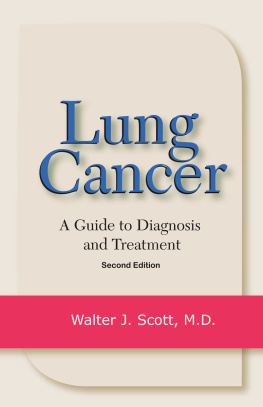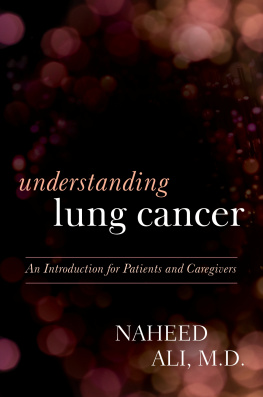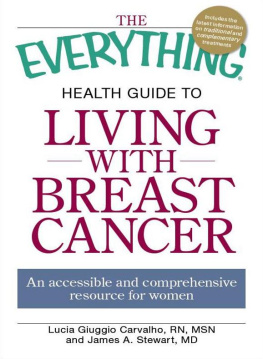
An Addicus Nonfiction Book
Copyright 2012 by Walter J. Scott, M.D. All rights reserved. No part of this publication may be reproduced, stored in a retrieval system, or transmitted in any form or by any means, electronic, mechanical, photocopied, recorded, or otherwise, without the prior written permission of the publisher. For information, write Addicus Books, Inc., P.O. Box 45327, Omaha, Nebraska 68145.
ISBN 978-1-886039-09-4
Interior design by Jack Kusler
Illustrations by Jack Kusler
This book is not intended to be a substitute for a physician, nor do the authors intend to give advice contrary to that of an attending physician.
Library of Congress Cataloging-in-Publication Data
Scott, Walter, 1954
Lung cancer : a guide to diagnosis and treatment / Walter J. Scott. -- 2nd ed.
p. cm.
Includes index.
ISBN 978-1-886039-09-4 (pbk.)
1. Lungs--Cancer--Popular works. I. Title.
RC280.L8S36 2011
616.99424--dc23
2011042503
Addicus Books, Inc.
P.O. Box 45327
Omaha, Nebraska 68145
www.AddicusBooks.com
Printed in the United States of America
10 9 8 7 6 5 4 3 2 1
Contents
Acknowledgments
T his book would not have been possible without the efforts of a great many people. Most importantly, I wish to express my gratitude to my patients and their families. Their willingness to share their personal experiences with me has been a source of inspiration and renewal.
I also wish to thank the members of the Fox Chase Cancer Center Multidisciplinary Thoracic Service and the rest of the staff at Fox Chase Cancer Center, in Philadelphia, for their commitment to improving care for patients with lung cancer. Thanks also to the medical students, residents, and fellows at Fox Chase for their hard work and tough questions.
I am grateful for the support of Rod Colvin and Jack Kusler of Addicus Books. Their patience and guidance throughout the preparation of the manuscript have helped make this a much more useful book.
I thank Addison Tolentino, M.D., medical oncologist and co-author of Colon and Rectal Cancer, for his help with the chapter on chemotherapy. I also thank Carol Kornmehl, M.D., radiation oncologist and author of The Best News about Radiation Therapy, for her contribution to the chapter on radiation therapy. In addition, I thank Mark Pool, M.D., laboratory medical director at Riverside Medical Center, in Kankakee, Illinois, for his help with the development of this book.
Finally, a special thanks goes to my wife, Christine Beardmore, M.A., a psychotherapist, for her help with the chapter on emotional support.
Introduction
I f you are reading this book, you or someone you care about has probably been diagnosed with lung cancer. Over the years, many of my patients have told me that, after their diagnosis, they were overwhelmed by the sheer number of medical tests, procedures, and treatments they had to undergo. It is my intention in writing this book to take away some of the fear of the unknown and provide you with answers to the pressing questions you have about your diagnosis and treatment.
If you have been diagnosed with lung cancer, your survival and your quality of life depend on understanding your options and making sure you receive the best available treatment. Thanks to new treatments and new combinations of treatments, thousands of men and women survive lung cancer each year. My wish is that you will receive the best possible treatment so that you can improve your chances of becoming a lung cancer survivor.
Walter J. Scott, M.D., F.A.C.S.
Lung Cancer: An Overview
H asnt it seemed that cancer was always something that happened to someone else? But now, you or perhaps a loved one has been diagnosed with lung cancer. Your initial reaction may have been shock or that feeling of dread that comes with having your worst fears confirmed. You may feel sad, confused, and scared. These are normal reactions.
After receiving the initial diagnosis, you may have wondered what happens next? What medical tests will you undergo? What treatment will you need? Hopefully, the chapters that lie ahead will answer many of your questions. To start, however, this first chapter will give you a basic understanding of lung cancer.
How Lung Cancer Develops
Cancer is a collection of cells growing out of control. The cells in our bodies are constantly growing, and each cell contains a set of instructions, like software in a computer, that regulate cell behavior. Sometimes, a change, or mutation, occurs in a cells growth pattern. When these mutations continue to occuras many as ten to twenty may be requiredthe once-normal cells begin to grow abnormally. These new growths are called cancers.
Lung cancer usually arises from the cells that line the airways and the nearby mucous glands. When the airways are exposed to toxins we inhale, the transformation of normal cells to cancer begins with a condition called hyperplasiaan increase in the number of cells lining one part of the airways through which we breathe. This is followed by the development of dysplasia, which is an increase in the number of abnormal cells that line the airways. From this point, malignant cells can emerge. If left untreated, these cells can continue to grow and invade surrounding tissues.
Lung Anatomy

Each lung is divided into lobes. The right lung has three lobesupper, middle, and lower. The left lung has two lobesupper and lower.
How Lung Cancer Spreads
There are three ways cancer can spread: into surrounding tissues from the original tumor, through the blood, or through lymph nodes. The lymph nodes are part of the bodys immune systemthey filter the blood for foreign particles, such as bacteria or cancer cells. There are hundreds of lymph nodes throughout your body. Normally, when not inflamed or cancerous, lymph nodes are the size of raisins. Lung cancer can spread to lymph nodes in the chest.
In addition to spreading to lymph nodes, the malignant cells can escape into the bloodstream and travel throughout the body. Lung cancer most commonly spreads to the liver, but can also spread to the bones, bone marrow, brain, and adrenal glands. When a secondary cancer forms in any of these organs, it is called a metastasis.
Types of Lung Cancer
There are more than a dozen types of lung cancer, but more than about 90 percent of them fall into two main categories: non-small cell lung cancer and small cell lung cancer. These two forms of lung cancer grow differently and are also treated differently. Whether the cancer is non-small cell or small cell is determined by the size and other characteristics of the cancer cells as they appear when viewed through a microscope.
Non-Small Cell Lung Cancer
Approximately 80 percent of all lung cancers fall into the category of non-small cell lung cancer. Its called non-small cell because when viewed through a microscope, the cells appear largeor non-small. There are two main forms of non-small cell lung cancer: adenocarcinoma and squamous cell carcinoma.
Adenocarcinomas are usually found in the outer edges of the lung and arise from the tiny glands that produce mucus in the smaller airways (called
Next page














